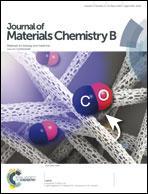Poly(ethylene glycol)-block-poly(4-vinyl pyridine) as a versatile block copolymer to prepare nanoaggregates of superparamagnetic iron oxide nanoparticles†
Abstract
This work reports an efficient method for the preparation of aqueous dispersions of superparamagnetic iron oxide nanoparticles (SPIONs), involving the use of an amphiphilic block copolymer, poly(ethylene glycol)-block-poly(4-vinyl pyridine) (mPEG-b-P4VP). The iron oxide nanoparticles are easily and efficiently dispersed due to the strong direct interaction of the hydrophobic P4VP segments, through complexation with pyridine units of the copolymer. Well-defined block copolymers, having different compositions and molecular weights, were prepared by atom transfer radical polymerization (ATRP). The aqueous self-assembly behavior of each system has been compared based on the method of preparation. The results revealed that the addition of ionic species has a significant effect on the size and type of formed nanostructures, the magnitude of which is dependent on the block copolymers' molecular design. When similar self-assembly strategies were used in the presence of SPIONs, the same type of nanostructures was formed. The hybrid SPION nanoaggregates were investigated using NMR relaxometric techniques, whereby high r2/r1 relaxivity ratios were achieved, making these materials potentially efficient T2-weighted MRI contrast agents.


 Please wait while we load your content...
Please wait while we load your content...